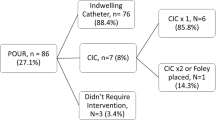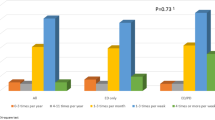Abstract
Penile prosthesis implantation is the definitive treatment for refractory erectile dysfunction, yet exposure to this procedure during training of urology residents is often limited. To assess the effects of resident participation in penile prosthesis surgery, we compared surgical outcomes in a retrospective case series of 253 penile prosthesis surgeries by a single surgeon at the same institution between 2017 and 2020 with the assistance of either a registered nurse first assistant (RNFA) or a resident. Pertinent patient characteristics and surgical complications including device complications, surgical site infection, postoperative bleeding, iatrogenic injury, cardiovascular events, pulmonary events, and urinary retention were documented. Measured outcomes included operative time, Emergency Room (ER) visits, unplanned postoperative visits, pain medication refills, and surgical complications. Compared to RFNAs, resident-assisted penile prosthesis surgery was associated with significant increase in mean operative time (71.4 min vs. 87.9 min, p < 0.01) and postoperative ER visits (3.0% vs. 10.6%, p = 0.03) but not surgical complications (19.7% vs. 20.8%, OR 1.03, 95% CI [0.46 −2.30]) or other measured outcomes. Compared to a dedicated RFNA, Resident assistance increased operative time by approximately 17 min, but did not increase post-operative surgical complications, supporting the notion that resident assistance in these procedures may be appropriate as an integral part of training.
This is a preview of subscription content, access via your institution
Access options
Subscribe to this journal
Receive 8 print issues and online access
$259.00 per year
only $32.38 per issue
Buy this article
- Purchase on Springer Link
- Instant access to full article PDF
Prices may be subject to local taxes which are calculated during checkout
Similar content being viewed by others
Data availability
Study data will be made available to interested parties upon direct request to the corresponding author.
References
Laumann EO, Paik A, Rosen RC. Sexual dysfunction in the United States: prevalence and predictors. JAMA. 1999;281:537–44.
Lee DJ, Najari BB, Davison WL, Al Hussein Al Awamlh B, Zhao F, Paduch DA, et al. Trends in the utilization of penile prostheses in the treatment of erectile dysfunction in the United States. J Sex Med. 2015;12:1638–45.
Mulhall JP, Ahmed A, Branch J, Parker M. Serial assessment of efficacy and satisfaction profiles following penile prosthesis surgery. J Urol. 2003;169:1429–33.
Saavedra-Belaunde JA, Clavell-Hernandez J, Wang R. Epidemiology regarding penile prosthetic surgery. Asian J Androl. 2020;22:2–7.
Manfredi C, Fortier É, Faix A, Martínez-Salamanca JI. Penile implant surgery satisfaction assessment. J Sex Med. 2021;18:868–74.
Kovac JR. Centers of excellence for penile prosthetics are a novel concept that will likely prove difficult to implement. Transl Androl Urol. 2017;6:S898–9.
Oberlin DT, Matulewicz RS, Bachrach L, Hofer MD, Brannigan RE, Flury SC. National practice patterns of treatment of erectile dysfunction with penile prosthesis implantation. J Urol. 2015;193:2040–4.
Damadi A, Davis AT, Saxe A, Apelgren K. ACGME duty-hour restrictions decrease resident operative volume: a 5-year comparison at an ACGME-accredited university general surgery residency. J Surg Educ. 2007;64:256–9.
McAbee KE, Pearlman AM, Terlecki RP. Infection following penile prosthesis placement at an academic training center remains low despite involvement of surgeons-in-training. Investig Clin Urol. 2018;59:342.
Mahan ME, Parker DM, Fluck M, Gabrielsen JD, Petrick AT, Horsley RD. First assistant impact on early morbidity and mortality in bariatric surgery. Surg Obes Relat Dis. 2019;15:1541–7.
Yuce TK, Holmstrom A, Soper NJ, Nagle AP, Hungness ES, Merkow RP, et al. Complications and readmissions associated with first assistant training level following elective bariatric surgery. J Gastrointest Surg. 2021;25:1948–54.
Archie JP. Influence of the first assistant on abdominal aortic aneurysm surgery. Tex Heart Inst J. 1992;19:4–8.
Dindo D, Demartines N, Clavien P-A. Classification of surgical complications: a new proposal with evaluation in a cohort of 6336 patients and results of a survey. Ann Surg. 2004;240:205–13.
Matulewicz RS, Pilecki M, Rambachan A, Kim JYS, Kundu SD. Impact of resident involvement on urological surgery outcomes: an analysis of 40,000 patients from the ACS NSQIP database. J Urol. 2014;192:885–90.
Privé B, Kortleve M, van Basten JP. Evaluating the impact of resident involvement during the laparoscopic nephrectomy. Cent European J Urol. 2019;72. https://doi.org/10.5173/ceju.2019.0021.
McMillan DT, Viera AJ, Matthews J, Raynor MC, Woods ME, Pruthi RS, et al. Resident involvement and experience do not affect perioperative complications following robotic prostatectomy. World J Urol. 2015;33:793–9.
Baber J, Staff I, McLaughlin T, Tortora J, Champagne A, Gangakhedkar A, et al. Impact of urology resident involvement on intraoperative, long-term oncologic and functional outcomes of robotic assisted laparoscopic radical prostatectomy. Urology. 2019;132:43–8.
Ruhotina N, Dagenais J, Gandaglia G, Sood A, Abdollah F, Chang SL, et al. The impact of resident involvement in minimally-invasive urologic oncology procedures. CUAJ. 2014;8:334.
Meyer CP, Hanske J, Friedlander DF, Schmid M, Dahlem R, Trinh VQ, et al. The impact of resident involvement in male one-stage anterior urethroplasties. Urology. 2015;85:937–41.
Caras RJ, Lustik MB, Kern SQ, Sterbis JR, McMann LP. Laparoscopic radical prostatectomy demonstrates less morbidity than open radical prostatectomy: an analysis of the American College of Surgeons-National Surgical Quality Improvement Program database with a focus on surgical trainee involvement. J Endourol. 2014;28:298–305.
Allard CB, Meyer CP, Gandaglia G, Chang SL, Chun FKH, Gelpi-Hammerschmidt F, et al. The effect of resident involvement on perioperative outcomes in transurethral urologic surgeries. J Surg Educ. 2015;72:1018–25.
Lacy JM, Walker J, Gupta S, Davenport DL, Preston DM. Risk factors for removal or revision of penile prostheses in the veteran population. Urology. 2016;98:189–94.
Miller JA, Bennett NE. Comparing risk factors for adverse outcomes in virgin inflatable penile prosthesis implantations and revisions: a retrospective cohort study. Sex Med. 2020;8:388–95.
Carson CC, Mulcahy JJ, Harsch MR. Long-term infection outcomes after original antibiotic impregnated inflatable penile prosthesis implants: up to 7.7 years of followup. J Urol. 2011;185:614–8.
Mulcahy JJ, Carson CC. Long-term infection rates in diabetic patients implanted with antibiotic-impregnated versus nonimpregnated inflatable penile prostheses: 7-year outcomes. Eur Urol. 2011;60:167–72.
Author information
Authors and Affiliations
Contributions
All authors have substantial contributions to this work. All authors were involved in the acquisition, analysis, and interpretation of data for the work, with final statistical analyses performed by SCW. SCW, ARS, JMJ, and MSG all contributed to drafting the paper and revised it critically for important intellectual content including final approval of the version to be published. All authors are in agreement to be accountable for all aspects of the work in ensuring that questions related to the accuracy or integrity of any part of the work are appropriately investigated and resolved.
Corresponding author
Ethics declarations
Competing interests
The authors declare no competing interests.
Additional information
Publisher’s note Springer Nature remains neutral with regard to jurisdictional claims in published maps and institutional affiliations.
Supplementary information
Rights and permissions
Springer Nature or its licensor holds exclusive rights to this article under a publishing agreement with the author(s) or other rightsholder(s); author self-archiving of the accepted manuscript version of this article is solely governed by the terms of such publishing agreement and applicable law.
About this article
Cite this article
Wu, Sc., Swanton, A.R., Jones, J.M. et al. New findings regarding the influence of assistants on surgical outcomes in penile prosthesis implantation. Int J Impot Res 35, 736–740 (2023). https://doi.org/10.1038/s41443-022-00624-x
Received:
Revised:
Accepted:
Published:
Issue Date:
DOI: https://doi.org/10.1038/s41443-022-00624-x



